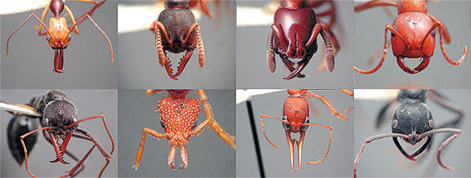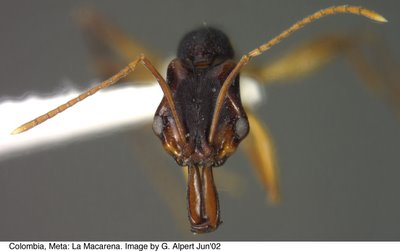 Make your own picture sudoku with photos from flickr. I just made the one above using photos from JochenB's lovely gallery of ant portraits. Link via Make
Make your own picture sudoku with photos from flickr. I just made the one above using photos from JochenB's lovely gallery of ant portraits. Link via MakeIn which I will be keeping track (for my own benefit) of my daily progress in the identification of the ant fauna of Tiputini Biodiversity Station in Ecuador, the analysis of that data, and the pursuit of my PhD. And (for the benefit of everyone else) I hope to provide helpful information on ants, taxonomy, database management, identification, and other assorted endeavors. Cheers
Friday, September 29, 2006
DIY Ant Sudoku
 Make your own picture sudoku with photos from flickr. I just made the one above using photos from JochenB's lovely gallery of ant portraits. Link via Make
Make your own picture sudoku with photos from flickr. I just made the one above using photos from JochenB's lovely gallery of ant portraits. Link via MakeThursday, September 28, 2006
Procrastinating with silly scientific journals
- Annals of Improbable Research
- Journal of Irreproducible Results
- Journal of Insignificant Research
- Brighter Biochemistry
- Dopeia
- The Tea Phytologist
- Worm Runner’s Digest
Any others?
Tiputini Video and Research Links
 Myrmecologist and filmmaker Amy Mertl has just posted a new video to her webpage on Yasuni National Park and the Tiputini Biodiversity Station in Ecuador. It is "a short documentary on the incredibly diverse Yasuni National Park in Amazonian Ecuador and the threats it faces from the construction of oil roads. Includes interviews with Kelly Swing and Jaime Guerra." Check it out.
Myrmecologist and filmmaker Amy Mertl has just posted a new video to her webpage on Yasuni National Park and the Tiputini Biodiversity Station in Ecuador. It is "a short documentary on the incredibly diverse Yasuni National Park in Amazonian Ecuador and the threats it faces from the construction of oil roads. Includes interviews with Kelly Swing and Jaime Guerra." Check it out.I enjoyed watching this video immensely. It made me really nostalgic for the station. I realized I haven't been back (or anywhere in the field) since 2003. I really miss it! Tiputini Biodiversity Station is such an amazing place. I've been inspired to troll the net for various links to it and I encourage all researchers to consider it as a possible field site. And let me know of other links, too!
 Tiputini Links:
Tiputini Links:Wikipedia entry
Official TBS website
NPR series on Tiputini: The Hidden Language of Insects
- Societies of Sound in the Forest
- A Journey to the Edge of the Amazon
- Engineer's notebook: the Wilderness Chorus
The Tadpole Organization -- conducting amphibian surveys and research at Tiputini. "The alpha diversity of amphibians recorded at the site exceeds all other reported locations and exemplifies the region’s exceptional biodiversity."
Anfibios del Parque Nacional Yasuní -- Fantastic site on the amphibians of Yasuni with photos, movies, sound recordings, lists of species, and other information (in Spanish)
Tiputini Climatological Data -- "climatological information compiled by Dr. Jaime Guerra at the Tiputini Biodiversity Station in Amazonian Ecuador is available (for Mac and PC equipment) in graphic form. Weather data are presented for all standard parameters (rainfall, wind speed and direction, luminosity, etc.) from 1998 through the present. In the event that raw data are required by any investigator, these can be made available upon request." (scroll to bottom of page)
Video clips from students on the tropical ecology program at Tiputini.
 Yasuni Rainforest Campaign -- "The Most Biologically diverse place on earth." Current news stories, information about the indigenous Huaorani, letters of support from organizations and individuals (including EO Wilson and Jane Goodall), and diversity maps.
Yasuni Rainforest Campaign -- "The Most Biologically diverse place on earth." Current news stories, information about the indigenous Huaorani, letters of support from organizations and individuals (including EO Wilson and Jane Goodall), and diversity maps.Diversity and biogeography of vascular epiphytes in Western Amazonia, Yasuní, Ecuador (PDF)-- a paper published in the journal of biogeography. Also includes a Species list of vascular epiphytes from the Tiputini. I think I remember these guys from when I was at the station. One of them had a botfly in his head.
John Blake's website on the structure and organization of bird communities at Tiputini. His site includes a map of his plots and a protocol for other researchers who would like to utilize his plots.
Turtles of Tiputini
Beetle Diversity -- canopy fogging paper by Erwin et al.
 Ants of Tiputini
Ants of TiputiniPheidole of Tiputini
Kimberly Holbrook, research on toucans at Tiputini
Understanding biophysical and landscape controls on spatial patterns of tree diversity -- a paper using Tiputini as a field site
A personal essay on the experience of being at Tiputini, with a cameo by Ben Rinehart, bat researcher extraordinaire and fellow BU grad student. A story about Ben: One day I was walking towards the elevator and bumped into Ben, garbed in field gear, net in hand, who grumbled: "I bet you don't have to go out when some lady finds an ant in her garage." Struth.Article on Cheliomyrmex at Tiputini
Bostonia article on TBS
Wednesday, September 27, 2006
Timorous Beasties


 Look at these fabulous designs from the even more fabulously named store Timorous Beasties!
Look at these fabulous designs from the even more fabulously named store Timorous Beasties!(via BoingBoing via CribCandy).
Wednesday, September 20, 2006
The two most powerful forces
 E. O. Wilson's new book, The Creation, is an attempt to get two groups of disparate folks -- scientists and evangelical Christians -- together on the one issue that Wilson believes they can agree on: saving life on earth.
E. O. Wilson's new book, The Creation, is an attempt to get two groups of disparate folks -- scientists and evangelical Christians -- together on the one issue that Wilson believes they can agree on: saving life on earth.As Wilson says, science and religion are "the two most powerful forces in the world today." What wonders could be accomplished if they were on the same side?
Here is a link to an article in the Washington Post.
And another link to an interview with Wilson and Dr. Gerald Durley, Pastor of the Providence Missionary Baptist Church of Atlanta, Georgia, on NPR.
Monday, September 18, 2006
Wasmannia
 Drawing by Christine Parent
Drawing by Christine ParentI have just finished updating my Wasmannia page. Previously I had been using the Costa Rica key, which is somewhat helpful, but I knew I definitely had ants that weren't there. I had heard a new revision and key was coming out soon, but this has yet to actually appear. Luckily, I was able to talk to Jack Longino at the IUSSI conference and he kindly forwarded a copy of the new key to me. Happily, it was fairly straightforward and easy to use and I am confident in my identifications. My species list now has W. auropunctata, W. iheringi, W. lutzi, W. rochai, W. scrobifera, and W. sigmoidea. There is even a key to queens so I was able to identify those, too. Some notes:
W. auropunctata: this one is very easy to identify due to its strongly quadrate petiole (see picture above). Scrobifera also has a quadrate petiole but the clypeus shape is completely different (see below).
W. iheringi: I'm not positive, but I believe that the species which is currently labeled as JTL-001 on the Ants of Costa Rica site is iheringi. The petiolar peduncle is very long, there is no erect hair on the gaster. All of my specimens were collected from canopy fogging samples, including several queens.
W. lutzi: this species is closely related to affinis, which I did not collect. They both have scrobes which are wide and flat and reach all the way to the sides of their head. lutzi differs from affinis by having longer propodeal spines which are about as long as the space between them. Also the postpetiole is strongly punctate and opaque and more trapezoidal or quadrate than elliptical. Also it looks like it has only been collected from Brazil, so I guess my having found them in Ecuador is fairly significant. They were all collected from the canopy.
W. rochai: I only have a single specimen of this, collected from the canopy. It is similar to sigmoidea but is smaller, the propodeal spines are shorter and curved downwards, and the setae are more curved and a bit clavate.
W. scrobifera: Has a quadrate petiole like auropunctata but the clypeus looks completely different -- strongly projecting at a right angle. Scapes are flatter and setae are shorter than in auropunctata. My specimens were collected in the canopy and with winklers
W. sigmoidea: Similar to rochai but a little larger, propodeal spines are a little larger and upturned, setae are not as curved or clavate as rochai. I found myself having a little bit of trouble confusing the petioles for auropunctata, but they are not quite as quadrate and the anterior and dorsal faces meet in a more sloping manner. My specimens were collected in winklers, pitfalls, and hand collected.
There are tons of webpages and photos out there of Wasmannia auropunctata but almost nothing of any of the other species. Here are a few links:
Ants of Costa Rica species list
Original description of genus, partly in English
Original description of W. scrobifera
Some basic info on the genus from the Ants of North America
Sunday, September 17, 2006
Virtual Ant Colony
Well, it's the weekend, so I give myself permission to not feel bad about having two entries in a row regarding silly ant things to buy. Sometimes you just have to veg.
I had one of those gel ant farms on my desk for awhile but they all died. Perhaps I should give this computer ant farm a try:
"Bandai is set to release Ant's Life Studio this November in Japan, a virtual ant farm simulator that could very well become the next Tamagotchi. It's apparently being aimed at the hordes of Japanese men who do nothing but slave away at a tiny desk all day, working until their eyes fall out. Maybe Bandai's making some sort of social justice metaphor here, but, then again, they could just be wanting to cash in on a fun idea.Like real-world ant farms, people simply watch the virtual ants go on with their lives, moving dirt, making tunnels, getting nervous when approaching the queen to ask for a favor, etc. Up to 100 different nests can be built by the ants, ensuring that no matter how dull and meaningless your work day is, you can always watch your pets toil away."
Bandai's Ant's Life Studio via Tokyo Times via gizmodo
Be sure to watch the two movies on the Bandai website. Don't have any idea what they are saying, but they look kinda fun.
Wednesday, September 13, 2006
Ebay item of the week: Stairs for the Soul

Auction ends September 18
Link
Monday, September 11, 2006
Morphological and Functional Diversity of Ant Mandibles

I just found this very nice site authored by Chris Schmidt on the morphological and functional diversity of ant mandibles. Awesome photos and very clear explanations. It is a treehouse on the Tree of Life. Check it out.
Update: Whoops! I forgot to include the link. Check it out here.
Tuesday, September 05, 2006
Anochetus bispinosus

Today I rechecked all of my Anochetus specimens. Why? Because I was browsing the Ants of Costa Rica web page and it said that Anochetus bispinosus was extremely rare and that in all the intensive collecting that had been done there they had only collected 3 workers from a single tree. And I have 4 specimens, so I started to doubt myself. Well, I have rechecked all of them and I am confident that all of my original identifications are correct, including the A. bispinosus specimens. It's actually a fairly easy key to deal with, and according to AntWeb, it has also been found in Brazil and Colombia, so it isn't crazy to find it in Ecuador. My four specimens (all workers) were collected by canopy fogging in 2 different trees fairly far removed from each other. I don't have pictures yet but they basically look exactly like the photos on the Ants of Costa Rica page.
More information:
From Bill and Emma Mackay's site -- a key to neotropical Anochetus can be found here.
From the Hymenoptera On-Line Database: Brown, W. L. 1978. Contributions toward a reclassification of the Formicidae. Part VI. Ponerinae, tribe Ponerini, subtribe Odontomachiti. Section B. Genus Anochetus and bibliography. Stud. Entomol. (N.S.) 20: 549-652. Browse or download entire file (5.3M)

From Jack Longino's Ants of Costa Rica site -- a key to Costa Rican species of Anochetus.
From the Hymenoptera Name Server -- a list of valid and invalid names including some original sources.
From AntWeb -- lots of Anochetus photos and specimen collection data.
From the MCZ Type Database -- a list of specimens at Harvard's Ant Room with lots o' photos. Just select "Hymenoptera" for Order and type in "Anochetus" under name.
From ponerine.org -- a really nifty list of Anochetus species which can be sorted taxonomically, alphabetically, by region, or by extant/extinct(ness). Awesome.

